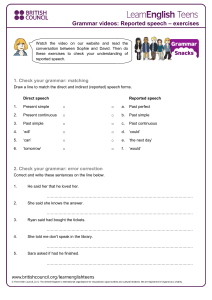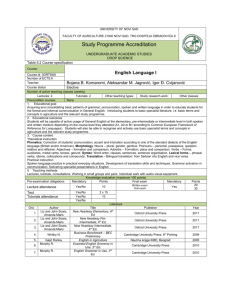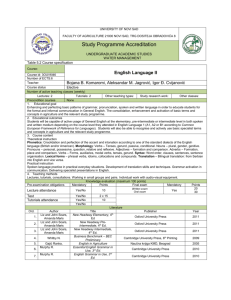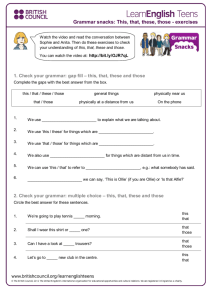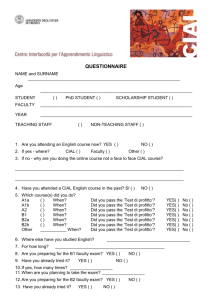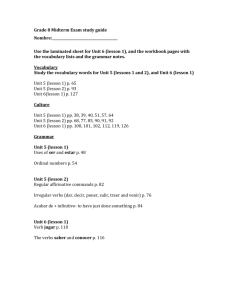2. Course Components
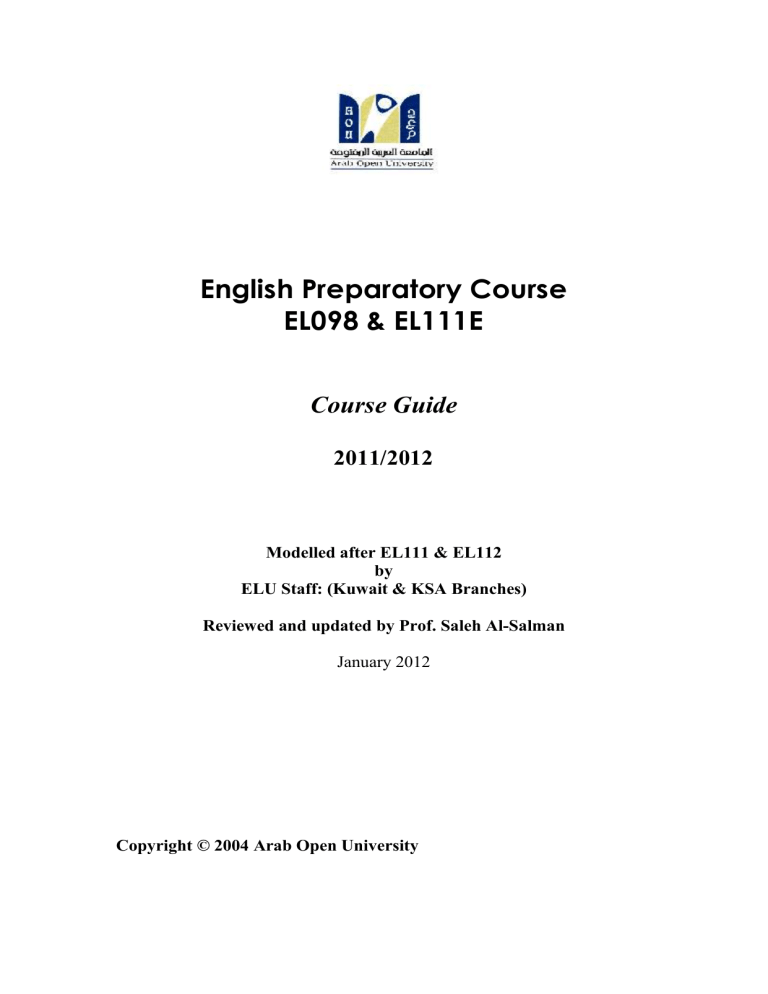
English Preparatory Course
EL098 & EL111E
Course Guide
2011/2012
Modelled after EL111 & EL112 by
ELU Staff: (Kuwait & KSA Branches)
Reviewed and updated by Prof. Saleh Al-Salman
January 2012
Copyright © 2004 Arab Open University
Copyright © 2004 Arab Open University
All rights reserved; no part of this publication may be reproduced, stored in a retrieval system, or transmitted in any form or by any means, electronic, mechanical, photocopying, recording, or otherwise without the prior written permission of the Arab Open University.
2
INTRODUCTION
Welcome to EL098 , English Remedial Course (level 2).
This Course
Guide provides you with an overall view of what you are required to do in order to complete the course smoothly and successfully. It also has a weekly
Study Calendar that offers a step-by-step breakdown of your tasks for each unit.
EL098 is a non-credit-hour course that runs for one semester (or term) of 15 weeks. It is the second of three courses in the English Orientation
Programme (EOP) which some incoming students are required to take during their first year of study.
EL098 is an intensive course that is meant to upgrade your overall proficiency in the English Language in order for you to be able to pursue more advanced English AOU courses (i.e., EL099, EL111 and EL112), and to eventually move to specialized OU-based courses.
EL098 adopts the traditional style of face-to-face instruction in order to provide you with ample opportunity to practice language skills (listening, speaking, reading and writing) in a communicative manner and thus it is essential that you attend each every teaching session/tutorial.
This Course Guide is a basic component of your course. We advise you to use it regularly in conjunction with the main course books, namely the
Student Book (SB) and Workbook (WB).
This guide contains essential information about course objectives, structure and components. It also contains information about supplementary and audio material, language tutorials, assessment and study skills/tips. You should read this part carefully before you begin with your course books.
The guide also contains:
1.
Study Calendar in which course units are evenly distributed over the semester weeks and if you follow it, you will have no problems in covering the course material in good time and in a smooth and comfortable manner.
2.
Tips on how to revise the teaching materials, and
3
3.
Information on the structure of the Final Examination and the type of questions it contains.
INTRODUCTION
Table of Contents
3
1. COURSE OBJECTIVES
2. COURSE COMPONENTS
2.1 Student’s Book (SB)
2.2 Workbook (WB)
2.3. CD-ROMS and Audio Cassettes/CDs
5
6
7
7
7
2.5. EL098 Online
2.6. Teacher’s Book
2.7. ITOOLS
3 . COURSE STRCTURE
4. UNIT STRUCTURE
4.1 Student’s Book
4.2 Workbook
4.3 Workbook Unit Structure
5. SUPPLEMENTARY MATERIAL
5.1. Relevant Sources
5.2. Online English
5.3. Relevant Online Language Programmes
5.4. What to Search for
6. TUTORS & LANGUAGE TUTORIALS
6.1. Your Tutor
6.2. Language Tutorials & Day Schools
6.3. Course Tutorials: Scope and Sequence
7. ASSESSMENT: AN OVERALL VIEW
7.1. Continuous Assessment
8
9
11
11
11
11
12
13
16
16
16
17
18
19
19
19 7.2. Final Examination
7.3. Assignments and quizzes
8. EL098 STUDY CALENDAR
20
9. YOUR FIRST WEEK 20
9.1. Check Course Material 20
9.2. Familiarize Yourself with Teaching Material 21
7
8
7
8
9.3. Read this Guide 21
9.4. Secure a Monolingual Dictionary 21
9.5. Check Your Understanding 21
9.6.
Your First Tutorial 21
10. FINAL EXAMINATION 22
10.1. Final Examination 22
4
1. COURSE OBJECTIVES
By the end of the course, students will be able to:
1.1.
Understand and extract the essential information from a written or spoken text on a familiar topic
1.2.
Scan a short written text for specific information.
1.3.
Predict the meaning of unfamiliar vocabulary items using contextual clues.
2.1. Control a range of isolated words and phrases dealing with concrete everyday topics like hobbies, shopping, food, eating, weather, seasons, household goods, city and country life, etc.
2.2. Perform a variety of social functions including greetings, introductions and farewells, making and responding to requests, suggestions, invitations and apologies, conducting simple transactions in shops and offices, asking for and giving directions, etc.
2.3. Describe people, places, likes and dislikes and daily routines in a series of simple phrases and sentences.
9.7.
Construct short and simple descriptive paragraphs about people, places and events.
9.8.
Write a clear topic sentence for a paragraph.
3.3. Use linking words and relative pronouns
(and/but/because/so/when/until) to organize sentences in a paragraph.
4.1. Understand the form and function of the basic tenses including present simple and continuous, past simple and “going to” future
4.2. Use a range of auxiliary verbs (am/is/are/was/were/can/could) and regular and irregular verbs.
5
4.3. Demonstrate awareness of the essential grammatical features and functions including question words, comparatives and superlatives, infinitives of purpose, countable and uncountable nouns, determiners, possessives and prepositions of place.
2. COURSE COMPONENTS
EL.098
is made up of components as shown in the following table:
No. Component
1. SB
Title
New Headway Plus (Elementary) with Interactive CD-ROM,
Qty.
1
2. WB New Headway Plus (Elementary),
(With audio CD, audio cassette )
2
3. Class audio
CDs and ACs
New Headway Plus (Elementary)
4. Course Guide EL098 : Course Guide
5. EL.098 Online CD-ROM with interactive tests, and grammar, vocab., and writing exercises.
New Headway online: available at: www.oup.com/elt/headway
6.
Teacher’s Book
New Headway Plus ( Elementary
Teacher’s Book)
7. iTools New Headway Plus iTools
5
1
NA
1
1
2.1. Student's Book ( SB )
The Student's Book contains 14 units.
In addition to the teaching material, the SB includes additional sections at the end of the book:
Tapescripts of the listening passages/exercises in each unit (pp114-
123)
Grammar reference (pp.124-134): discussion of key grammar points.
Word list (p.135 – 141)
A list of irregular verbs (p.142).
Verb patterns (p. 142)
Phonetic symbols (p. 143).
6
2.2. Workbook (WB)
The Workbook contains further consolidation exercises which revise the grammatical input of the Student’s Book, together with vocabulary exercises and language functions, in addition to speaking activities, dialogues, situational conversations and debates.
The Workbook provides further practice in grammar, vocabulary, and writing, in addition to speaking activities and listening tasks.
2.3. CD-ROMS and Audio Cassettes
Both the Student's Book and the Work Book (i.e
., New Headway Plus ) are accompanied by CDs and audio-cassettes .
It is important to remember that the teaching material on the CDs and ACs is an integral component of both the SB and WB. In addition, the exercises on them are related to the grammar points, vocabulary and language functions covered in every unit.
2.4. Course Guide
The Course Guide is the booklet you are reading right now.
2.5. EL098 Online
There is a teacher’s website with additional material for teachers: www.oup.com/elt/teacher/headway, and a student’s site with interactive practice exercises for students: www.oup.com/elt/headway
2.6. Teacher’s Book
The Teacher’s Book describes the rationale for the methodology of the course and provides extensive guidance on using the material effectively.
The Teacher’s Book includes:
Full teaching notes, answers, and possible problems.
Photocopiable material (p. 122 – p. 134)
7
Stop and check tests
There are four “Stop and Check” revision tests which cover Units 1-4,
5-8, 9-12, and 13-14. These can either be set in class, or given for homework (preferably over the weekend) and then discussed in the next lesson).
Progress tests
There are three progress tests, which cover Units 1-5, 6-10 and 11-14.
Answer Keys for the workbook (p. 155 – p. 160)
Don’t forget section which refers to relevant exercises in the
Workbooks, and to the Word list
2.7. iTools
The New Headway iTools is a new digital teaching and learning support material which brings a new dimension to your class by making it interactive.
The resources work alongside the course book, encouraging the students to join in and learn using new modes of interaction. New Headway iTools works on your Interactive Whiteboard, but can also be used with a computer and a data projector, or a computer on its own.
3. COURSE STRUCTURE
EL098 consists of one block to be covered in fifteen weeks . The structure of the block is summarized below:
The block consists of the teaching material in the main course book , namely New Headway Plus (Elementary): Student's Book and
Workbook .
New Headway Plus (Elementary): Student's Book consists of fourteen units. Each unit contains multi-thematic material of (1) "Language Input" section, covering: Grammar, Vocabulary and Everyday English, and (2)
"Skills Development" section, covering: Reading Speaking, Listening, and
Writing. The teaching material is both graded and varied.
New Headway Plus (Elementary): Workbook is an exercise book meant to reinforce, consolidate and expand the teaching points covered in each unit in the Student's Book .
8
The functional objectives of each unit are spelled out for you in the
Contents chart at the beginning of your SB.
Please observe the following abbreviations which will be used throughout this guide as well as in the Study Calendar .
Abbreviations:
ACs Audio Cassettes
NHP New Headway Plus
SB Student's Book
WB Workbook
4. UNIT STRUCTURE
4.1. Student’s Book
Each unit in your SB consists roughly of four sections as in the following table:
Section No.
Title
1
2
Grammar
Reading and Listening/Speaking
3 Vocabulary and
Pronunciation/Listening
4 Everyday English`
SB Unit Structure
Below is a brief description of each section (adapted from New Headway
Plus (Intermediate), Oxford University Press, 2006.
9
1. First Section: Grammar
This section consists of two parts:
Test Your Grammar : to introduce the theme of the unit.
Grammar Spot & Grammar Reference : to introduce some tips on grammar points with practice exercises and drills. The
"Grammar Reference" is found at the end of the book to elaborate on and explain key grammar points in the unit.
This section presents the target grammar of the unit. The presentation is followed by a variety of exercises which give you the opportunity to practice language structure and to use language communicatively.
2. Second Section: Reading & Speaking
This section contains high-interest readings and activities that reflect and extend unit themes. Reading strategies are presented and checked in comprehension exercises.
3. Third Section: Listening & Speaking
This second section integrates listening and speaking skills and activities. It also provides you with ample opportunities to practice listening, pronunciation and speaking. The "Tapescripts" supplement at the back of the SB (pp.114-123) supports this section.
4. Fourth Section: Vocabulary
This section contains different exercises and drills which aim at developing students' use of vocabulary in context. The vocabulary items are derived from the reading passages included in the SB (see word list pp. 135-141)
5. Sixth Section: Everyday English
This section is intended to help students establish a stock of everyday
English terms and expressions which are of international and global currency. The target words and expressions are not culture specific but they reflect current and recurrent issues of international concern.
4.2 Workbook
10
The workbook is an important component of the course. It revises the grammatical input of the Student’s Book and contains the writing syllabus.
Many of the exercises are on the Student’s Workbook recording, for use in class or at home.
The Workbook consists of the following major parts as in the following table:
Contents
1.
Language Input
Form and structure: verb to be, possessive adjectives, questions and negatives, possessive’s, present simple, prepositions of place, etc.
Vocabulary
Punctuation
Pronunciation
Listening
Speaking
Writing
2.
Phonetic symbols
4.3 Workbook (WB) Unit Structure
A typical WB unit includes an average of 13 exercises drilling the topics outlined in the WB contents section above. The exercises vary in their focus as they present a wide spectrum of recognition, synthesis, completion, matching, and correction exercises.
5. SUPPLEMENTARY MATERIAL
5.1. Relevant Sources
Amongst the most important relevant sources that will contribute significantly towards improving your language skills are:
(1) radio and TV newscasts, commentaries, programs, etc. transmitted
in English,
(2) English newspapers, magazines and books, and
(3) the Internet
11
Of these three sources, the Internet is probably the most relevant because through it you can have free access to a variety of English language courses addressed to foreign language learners. These courses, which will be discussed in some detail below, deal with various aspects of grammar, vocabulary, pronunciation, reading and writing. In addition, they provide you with ample opportunity to listen to English as spoken by native speakers. It is because of this that we refer you to specific sites to look for specific language topics in each and every unit.
5.2.
Online English
There are many sites which provide tuition and training in English. Most of these sites are not free of charge, i.e. they cannot be accessed unless access fees are paid. There are, however, some sites which can be accessed free of charge, and a number of them have been selected for you by the author of this guide to help you upgrade your English. They have been chosen on three grounds:
1.
The material is relevant to the course.
2.
The level of difficulty is appropriate.
3.
The content is culturally appropriate.
The significance of Online English courses/programmes manifests itself in that:
1.
They provide supplementary aid to you in such areas where you feel you need help that the core course material does not provide.
2.
Some of the exercises are interactive, and thus they are fun to do because they show you your scores of right and wrong. But be careful not to spend too many hours on them needlessly.
3.
They provide training in areas which otherwise require instruction by tutors, especially in pronunciation, and listening comprehension.
4.
The exercises are done in total privacy, so you are not embarrassed by the presence of other learners or by the tutor when you make a mistake. This encourages you to learn by trial and error, and a lot can be learned this way.
5.
All listening/pronunciation material presented is by native speakers of English.
6.
You can use the Internet whenever you are free. There is no fixed schedule.
7.
You can go at your own pace.
12
5.3.
Relevant Online Language Programmes
The language programmes most relevant to EL098 are:
5.3.1 Oxford University Press: New Headway
5.3.2. University of Ottawa English Program
5.3.3. Purdue University Online Writing Lab
5.3.4. British Council Learn English: Grammar Program
5.3.5. Other Relevant Sites
Below are basic facts about these websites. More details are to be found in
EL098 Online.
5.3.1 Oxford University Press: New Headway
(A) Website Address www.oup.com/elt/headway
(B) Contents
1 . Everyday English
2. Games
3. Grammar
4. Help
5. Test Builder
6. Vocabulary
5.3.2.
University of Ottawa English Programme
(A) Website Addresses
1. http://www.uottawa.ca/academic/arts/writcent/hypergrammar/bldsent.html
2. http://www.uottawa.ca/academic/arts/writcent/hypergrammar/grammar.html
3. http://www.uottawa.ca/academic/arts/writcent/hypergrammar/diction.html
4. http://www.uottawa.ca/academic/arts/writcent/hypergrammar/spelling.html
5. http://www.uottawa.ca/academic/arts/writcent/hypergrammar/paragraph.html
6. http://www.uottawa.ca/academic/arts/writcent/hypergrammar/misc.html
13
(B) Contents
1.
Building Sentences
2.
HyperGrammar
3.
Diction
4.
Spelling
5.
Writing Paragraphs
6.
Miscellaneous Topics
5.3.3.
Purdue University Online Writing Lab
(A) Website Address http://owl.english.purdue.edu/handouts/index/html
(B) Contents
1.
Grammar
2.
Punctuation
3.
Spelling
4.
Exercises
5.3.4.
British Council Learn English: Grammar Programme
(A) Website Address http://www.learnenglish.org.uk/grammar/definitions/index.html
(B) Contents
Articles
Conditionals
Conjunctions
Determiners
-ing or to ?
Modals
Prepositions
Relative Clauses
Reported Speech
Present Perfect
14
5.3.5. Other Relevant Sites
1. Reading www.eslus.com/LESSONS/READING/READ.HTM
www.eslbears.homestead.com
www.englishclub.net
www-eng.tp.edu.sg/
2. Listening www.EnglishListening.com
www.esl-lab.com
www.ompersonal.com.ar/omaudio/contenidotematico.htm
www.rong-chang.com
www.stonesoup.com/main2/listen.html
www.eslbears.homestead.com
http://www.bits.westhost.com
http://www.literacynet.org
http://www.cdponline.org
http://www.focusenglish.com/dialogues www.englishclub.com
www.soundsofenglish.org
www.fonetiks.org
3. Writing www.eslbears.homestead.com/writing.html
owl.english.purdue.edu/sitemap.html
www.georgetown.edu/faculty www.ohiou.edu/esl
4. Grammar www-eng.tp.edu.sg/ iteslj.org/c/games.html
www.elfs.com
15
englishplus.com/grammar www.oup.com/eltlheadway
5.4. What to Search For
The sites which have been recommended for you contain definitions and exercises on grammar, punctuation, spelling, pronunciation, vocabulary and writing.
Most categories are listed in their home page in alphabetical order. Read the home pages carefully before you begin to enter the relevant sites. It should be noted, however, that the material in these sites has much more than your course requires.
If you feel you still need additional training in a certain linguistic area, you can either explore it yourself in the sites or you could ask your tutor to help you.
6. TUTORS & LANGUAGE TUTORIALS
6.1. Your Tutor
The best way to introduce you to the concept of tutoring at the AOU is through some basic questions to which we have provided answers.
1.
Q: Who is your tutor?
A : Your tutor is a qualified specialist appointed by the AOU to teach, guide, and supervise you. In the AOU system, a tutor is assigned to a group of about twenty students.
2.
Q: Where can you find your tutor?
A : Tutors work full-time hours at AOU Regional Centers (Branches) whose addresses and contact numbers will be mailed to you at the beginning of the semester.
3.
Q: How to contact your tutor?
A : You can contact your tutor during tutorials and office hours.
Alternatively, you can make an appointment to meet him/her during office hours by phone, fax and/or e-mail.
4.
Q: How does your tutor help you?
A : Your tutor guides your study during tutorials. He/She marks your
16
assignments, MTA and your final examination. He/She also discusses with you any difficulties you may run into during your study.
5.
Q: How often do you have to see your tutor and why?
A : You are required to meet your tutor for tutorials and day-schools which are held at regular intervals as announced by the AOU through its communications with you. If due to compelling circumstances you are not able to attend a certain tutorial or a day-school, you are advised to keep in touch with him/her. You may also see your tutor in order to:
ask questions related to your study.
submit assignments.
seek advice on any aspect of your study.
6.2. Language Tutorials & Day-Schools
Language tutorials and study sessions are interactive classes adopting what is known as a learner-centered approach where most of the talking and discussions are done by you and your colleagues. As you no doubt know the skill of speaking cannot be developed through independent study. You need to talk to people who have similar interests. You also need to talk in a meaningful context. Language tutorials during day-schools are meant to provide you with ample opportunity to use English.
Day-schools, as their name suggests, provide face-to-face teaching during the day and involve all the students taking a particular course. Details about day-schools and language tutorials for this semester are shown below.
The main objectives of language tutorials and day-schools are:
(i) to upgrade your overall proficiency in English,
(ii) to improve your fluency in English,
(iii) to improve your pronunciation,
(iv) to facilitate your understanding of the teaching points in SB, and
the activities/exercises in WB, and
(v) to help you with any difficulty that you may encounter.
In view of these considerations, you should attend these language tutorials at day-schools on a regular basis. Furthermore, you should always come prepared to these academic activities. Above all, you should be an active participant in the language tutorials and teaching sessions.
6.3. Course Tutorials: Scope & Sequence
As pointed out, EL098 course is meant to be covered in one semester of fifteen weeks of regular face-to-face instructions. Each week consists of 4
17
teaching sessions conducted over four days (Saturday, Sunday, Tuesday and
Wednesday). Each session consists of 2 contact hours, thus making a total of
8 direct teaching hours per week. This means that you will have 60 sessions
(total of 144 contact hours) per semester. This will allow completion of the study material and sitting for two required tests, five assignments and a midterm assessment followed by the final examination at the end of the semester.
The following table shows the weeks during which these tutorials will take place as well as the topics/activities each tutorial covers. It is convenient to remind you that tutorials are interactive sessions in which you are expected to participate actively and constantly.
EL098 Calendar
Semester I – Academic Year 2011/2012
Classes
Week 1
Week 2
Week 3
Week 4
Week 5
Week 6
Week
Units to be Covered Assignment and Tests
(Unit 1)
Unit 2
Unit 3
Unit 4
Unit 5
Unit 6
Unit 7
Assignment 1
(Units 1-2 )
Test 1
(Units 1- 4)
Week 8
Week 9
Week 10
3/12 – 8/12
Week 11
Week 12
17/12 – 22/12
Week 13
Unit 8
Unit 9
Unit 10
Unit 11
Unit 12
Unit 13
Assignment 2
(Units 5-6)
Midterm Exam
(Units 1- 7)
Assignment 3
Units 8 – 9
Test 2
(Units 8-11 )
18
Week 14
Week 15
Unit 14
Assignment 4
(Units 12 – 13)
Assignment 5
(Unit 14)
Assessment Breakdown
1.
Two quizzes
2.
Mid-Term
3.
Participation
4.
Assignments (5), Homework,
Presentations, etc.)
5.
Final Examination
Total
20 %
15%
5%
10%
50%
100%
7. ASSESSMENT: AN OVERALL VIEW
There are two components of assessment for the course: continuous assessment , to which 50% of the overall mark is allocated, and a final examination to which 50% of the same mark is allocated.
7.1. Continuous Assessment (50%)
The Continuous Assessment consists of the following components:
50% of the overall mark is allocated for the continuous assessment. These grades are distributed as the following: Five assignments are given 10%, two tests are given 20%, one midterm assessment is given 15%, and participation which is given 5%.
Assessment
Number
Assessment
1 Assignment One
Week Grade
2%
2
3
4
5
6
)
Test 1
Assignment 2
) Units 5-6 (
Midterm Exam
Units 1- 7
(
Assignment 3
(Units 8 – 9)
Test 2
) Units 8-11 (
Beginning of week 3
Beginning of week 5
Beginning of week 7
Beginning of week 8
Beginning of week 10
Beginning of week 12
10%
2%
15%
2%
10%
19
7 Assignment 4
)
Units 12 – 13
(
Assignment 5
Beginning of week 14
2%
8 Beginning of week 15
2%
9
10
Participation
Final examination Decided by the
Headquarters
5%
50%
11 Total Grades 100%
12 Minimum passing score 50%
Assessment Strategy
EL098 has two equally weighted assessment components: a continuous assessment component and an examinable component.
Continuous assessment: 2 Quizzes 20%
1 MTA 15% [Extra weight given to the ‘writing’ component]
Participation 5%
Assignments 10%
Total 50%
Examinable component: the final examination constitutes 50% of this component and is allocated 50 marks.
If you do not score a minimum of 20/50 on your final exam, you will fail the course regardless of the marks you have obtained in the continuous assessment.
7.2. Final Examination (50%)
At the end of the course, there is a final examination. You should remember, however, that if you do not score a minimum of 20/50 on your final exam, you will fail the course regardless of the marks you have obtained in the continuous assessment.
8. YOUR FIRST WEEK
Check your material
Familiarize yourself with the teaching material
Read this Course Guide
Secure a monolingual dictionary
Check your understanding
Your first tutorial
8.1. Check Course Material
20
Have a quick look at the books and recordings you have in your possession now. The following is a checklist. Put a tick in front of the right items in the following list:
(1) New Headway Plus (Elementary)
Student’s Book &
Workbook, with CDs and ACs
(2) EL098 Course Guide (this booklet)
If you have not received any of these items, get in touch with your tutor immediately.
8.2. Familiarize yourself with the teaching material
(1) Have a quick look at the three sets of items in the above list.
8.3. Read this Guide
(1) Now, go over this guide very carefully. Make sure you read and understand every section. If you face any problem with any of the sections, get in touch with your tutor.
(2) While reading the guide, we advise you to check the information you read in the relevant section above:
1.
Course objectives
2.
Course components
3.
Course structure
4.
Unit structure
8.4. Secure a monolingual dictionary
It is important that you have at your disposal a reasonable monolingual dictionary, preferably one that provides, in addition to definitions and meanings, the following:
1.
pronunciation
2.
examples
On the other hand, if you have access to the Internet, you can utilize any of the online dictionaries. You can search for such dictionaries through the various "search" devices available on the Internet.
21
8.5. Check your understanding
After you have done all of the above, check your understanding by answering the following questions:
1.
How many units does New Headway Plus (Elementary) consist of?
2.
How many ACs are used with the New Headway Plus (Elementary)
SB?
3.
What does the final part in each unit in the Workbook consist of?
4.
What does Assignment stand for? How many Assignments are you expected to do this semester for EL098?
5.
What does SEP stand for? What is it? Where can you find it?
6.
How many tutorials and language sessions are you expected to attend this semester?
7.
When is your first tutorial due?
8.6.
Your first tutorial
Your first tutorial will take place this week. You will get information as to the exact time and place from your tutor. It is of the utmost importance that you attend this tutorial to meet your tutor and to be introduced to all aspects of this course. If for a compelling reason you cannot attend this tutorial, get in touch with your tutor to arrange for a meeting with him/her as soon as possible.
9. FINAL EXAMINATION
13.1.
Final Examination
Your Final Examination which carries 50 points (i.e. 50% of the overall grade) will consist of the following sections/components:
13.2.1. Reading (15 points)
13.2.2. Grammar (10 points)
13.2.3. Vocabulary (5 points)
13.2.4. Writing (20 points)
22
NOTICE
Notice that about 50% of the questions in your Final Examination will be adapted/ extracted from your SBs, WBs, and ACs. It is thus essential that you concentrate on all activities and exercises contained in each and every unit in your SB and WB.
Notice further that "unseen" material will be modeled on the material covered in the course books, the set book , and EL98 Online .
Below is a brief description of the type of tasks/questions that make up each of the exam sections.
13.2.1. Reading
This section will consist of one or more unseen texts. Each text will be followed by the following types of questions:
1.
Comprehension Questions (open-ended questions, choosing from alternatives (MCQs), fill in blanks, true or false etc.)
2.
Vocabulary Questions
3.
Questions on Reading Strategies (e.g. distinguishing between fact and opinion, identifying main idea, etc.)
4.
Evaluation Questions (e.g. making inferences, recognizing writer's tone, etc.)
5.
Textual Questions (e.g. understanding reference, understanding text organization, outlining a text, etc.)
13.2.2. Grammar
Grammar questions/tasks will be varied and they aim to test:
1.
Grammatical form (e.g. tenses), grammatical meaning (e.g. past time) or both.
2.
Ability to use grammatical forms to communicate meanings (i.e. functional use of grammar).
In most cases, the tasks in this section are as follows:
1.
Identifying (circling) the correct answer (choosing from alternatives: multiple-choice questions).
2.
Fill in gaps in a sentence or a text.
3.
Transform sentences (e.g. from active into passive; from direct into reported speech).
4.
What would you say in a given situation to express how you feel about something? (e.g. indifference, interest, doubt, etc).
23
13.2.3. Vocabulary
This section tests your ability to:
1. Know the meaning of important/key words derived from the reading
passages, vocabulary, and speaking exercises covered in the EL98 SB
and WB.
2. Understand word meaning in context.
3. Find the meanings of words through matching them with their
equivalents.
13.2.4. Writing
This section tests your ability to write different types of tasks; however, most important of all is to produce a piece of writing with simple and correct structure/grammar and a good application of the mechanics of writing.
Some types of writing tasks:
1.
Paragraphs (descriptive, persuasive, process, definitions, narrative)
2.
Letters (a personal letter, a letter of application, a letter of inquiry, etc.)
3.
Short compositions (e.g. narratives, explanation, persuasion, cause and effect).
24
